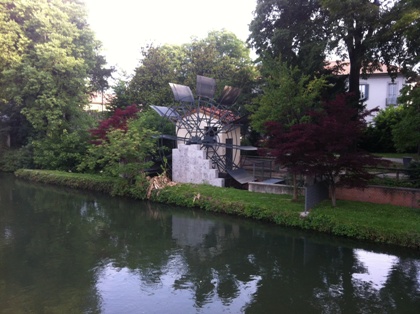
 Cycling on the Martesana canal : a pit stop in Cernusco and then to the village Crespi d’Adda
Cycling on the Martesana canal : a pit stop in Cernusco and then to the village Crespi d’Adda

filled by Giulia & Romeo

The Martesana is one of the jewels of Milan City ... among the skyscrapers of Melchiorre Gioia has started a bike ride that will sweep away the gray, the smog and the noise typical of the urban centres and will catapult you into the lush green that grows on its banks .
Designed by Leonardo da Vinci and opened by Ludovico il Moro, here are his measurements:
it is a waterway off from 9 to 18 meters deep from one to 3 meters long and long 38 km (some underground) connecting Milan with the river Adda, from which it receives the waters in Concesa, just downstream of Trezzo d’Adda. On its way crosses the towns of Trezzo d’Adda, Vaprio d’Adda, Cassano d'Adda, Inzago, Bellinzago Lombardo, Gessate, Gorgonzola, Bussero, Cassina de Pecchi, Cernusco sul Naviglio, Vimodrone and Cologno Monzese. Log in Milan in via Idro, a suburb northeast of the city, and slides open to the Cassina de 'Pomm at the corner with Via Melchiorre Gioia.
The advantage is that the Metro Green follows him in his path, and you can then decide how to sit on public transport and how riding by bicycle.
On a beautiful sunny day it will be pleasant to ride along its banks admiring the villas on the other side ... To stop for a sandwich or an ice cream, we suggest Cernusco sul Naviglio, which has a center area with limited traffic among the largest of Martesana, and an enviable standard of about 40 square meters of public green space per inhabitant.
In the eighteenth century the nobles, first of all the Austrian imperial family, spent their holidays here. They are to be admired Villa Visconti Alari Saliceto, Villa Greppi, Villa Carini Gervasoni and Villa Uboldo , now home of the hospital. The river is accompanied throughout by the municipal Blu park of Germani of 3 km in length which also includes the right bank of the historic gardens. Near the city center on the right side you can see a water wheel, rebuilt in 2007. Beyond the bike ride it is pleasant, for lovers of history and culture should not miss a visit to the former workers village of Crespi d'Adda, World Heritage of Culture of Unesco.
The factory and the village of Crespi d'Adda were built at the turn of the century by the Crespi family of industrial cotton, when in Italy the modern industry was born.
And it is certainly the most important witness in Italy of the phenomenon of workers villages: it has been one of the most comprehensive and original creations of the world and it has been preserved intact to our days. The idea was to give to all employees a small villa with garden and orchard, and provide all necessary services to the community: church, school, hospital, recreational club, theater, public baths, cemetery. Besides the homes of the workers in the twenties were added the villas of the directors, foremen and employees. The manor house of lords Crespi was instead built like an imposing medieval castle. The cemetery is now a national monument and inside there is the Crespi Chapel , a tower block and concrete pyramid decorated that stands to embrace the workers' s tombs, little crosses arranged in neat in the lawn.
The entrance of the Crespi cotton mill is now the most famous image from the visitors. Almost a cathedral to the work and to the industry, where the chimney, the management buildings and wrought iron gates create an unique architectural design, symbol of the industry at the turn of the nineteenth and twentieth centuries.
Today the village is home to a community largely descendants of the laborers who have lived or worked: and the factory itself has remained in operation until 2004, always in the cotton textile industry.
|
|
 |






















